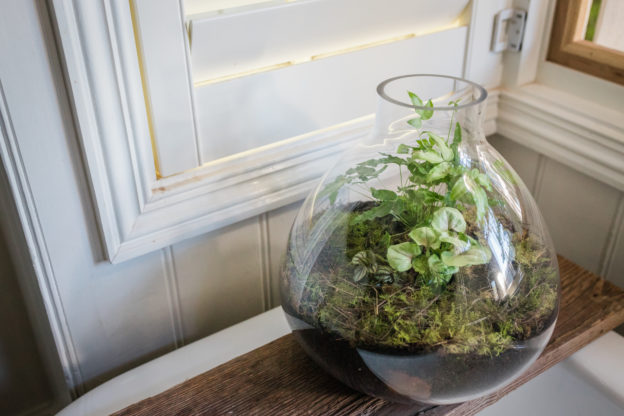Terrariums are a great option for those of us that don’t have a whole lot of outside space to play with. They’re stunning to look at, fairly simple to take care of and will likely last you a long time.
But every plant needs a little bit of TLC to thrive, and terrariums are no different!
Here are our top five tips for a happy terrarium.
Sunlight
Not every terrarium is the same, and some need more of the sun’s warming rays than others. It’s also important to remember that the glass container is essentially a greenhouse, so we don’t want to leave the terrarium in constant, direct sunlight – you’ll cook your plants!
Bright, indirect light is best for terrariums, so a north-facing window is usually a good spot. Aim for 4-6 hours of indirect light each day. Artificial light works too!
Just don’t move your plants around to avoid or catch the sunlight. Plants orient themselves towards the light and they won’t be very happy if they have to keep reorienting themselves. If you notice that the plants are only growing on one side, turn your terrarium gradually over a period of time to help even this out.
Soil
What soil you should use depends on the plants inside your terrarium. Cacti and succulents tend to thrive in soil that drains easily and doesn’t retain a lot of water, so it’s best to use specific succulent soil for these plants. For ferns, it’s best to use a premium indoor plant potting mix.
We recommend using a spray bottle when watering, as this will keep the terrarium’s soil moist but not wet. You should aim to top up the soil after a month or so, as this is when it will start to settle.
Water
As terrariums are closed systems, the entire water cycle should be happening on its own within the glass container. The best way to check if your terrarium has enough water is to check the amount of condensation on the glass. This will indicate how much moisture is in the air.
If you aren’t seeing any condensation, your terrarium needs more water. You’ll also notice wilting, dry soil and dead leaves if all is not well and moist inside the terrarium.
However, one of the more common mistakes people make is overwatering their terrariums. This is much more difficult to fix than underwatering, which is why it’s so important to take it slow and use a spray bottle. If you have heavy condensation and your soil is looking too wet, keep the terrarium open so it can dry out a little.
Keep it clean
Nobody likes living in a dirty home, and terrarium plants are no exception!
Dirty glass not only obstructs your view of your beautiful plants, but it can limit the amount of sunlight the terrarium is receiving. If you notice build up on the glass, just give the inside a wipe with a lint-free cloth and warm water.
Then we move onto plant waste.
Now, dead plants don’t mean that you’re a bad plant parent, it’s just the circle of life. However, terrariums aren’t able to break down organic material like a natural environment would, so you’re going to need to remove it yourself.
If you don’t remove dead plant matter straight away, it’s going to rot, which will lead to a smelly, unhealthy terrarium.
Mould
There is another organism which absolutely thrives in the hot, humid environment of your terrarium, and that’s the dreaded mould.
One spot of mould is nothing to stress about – it’s part of the decomposition cycle and should go away on its own in a couple of weeks.
However, if you do have stubborn mould that isn’t leaving or is actually spreading, there are a few options for treating it:
- Dip a Q-tip into hydrogen peroxide and apply a small wipe to the affected area
- Invest in some springtails to munch the mould away
- Spray with chamomile tea – the rich sulphur compounds make it a mild fungicide
Now that you’re an expert in terrarium care, learn how to make your own from scratch in our Feed Your Soul With Flowers online course!
Looking for expert advice on Indoor Plants? USE THIS LINK >>>>
